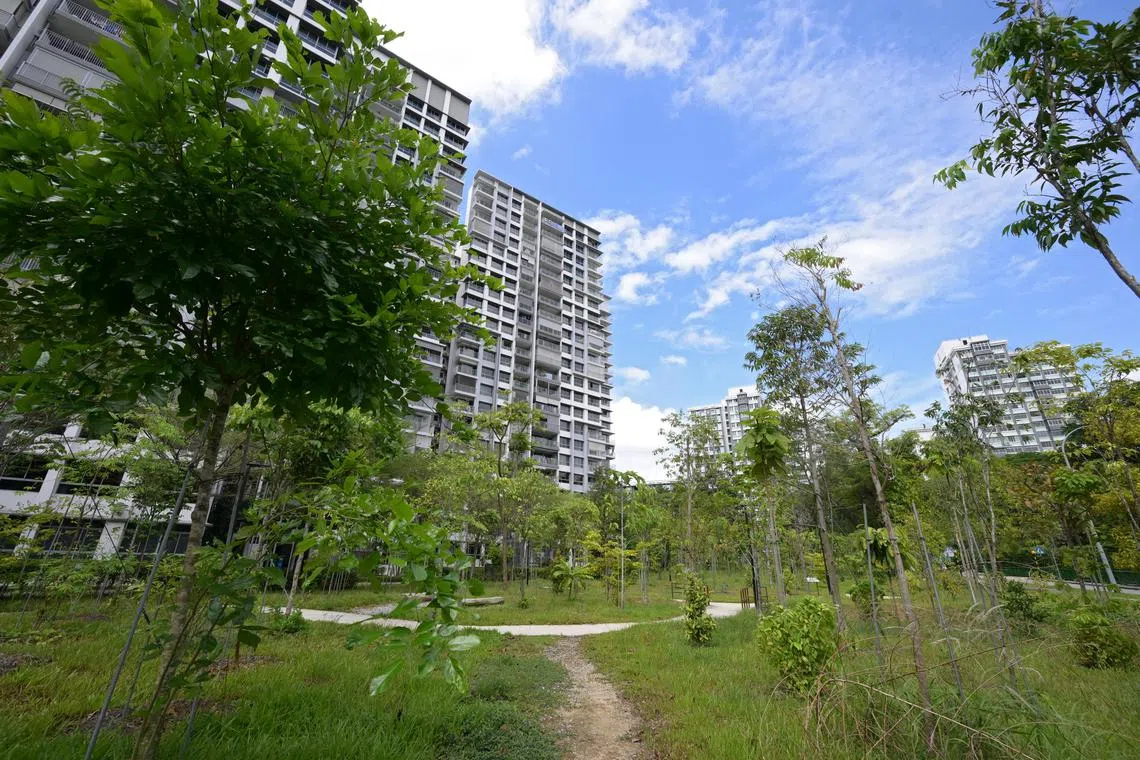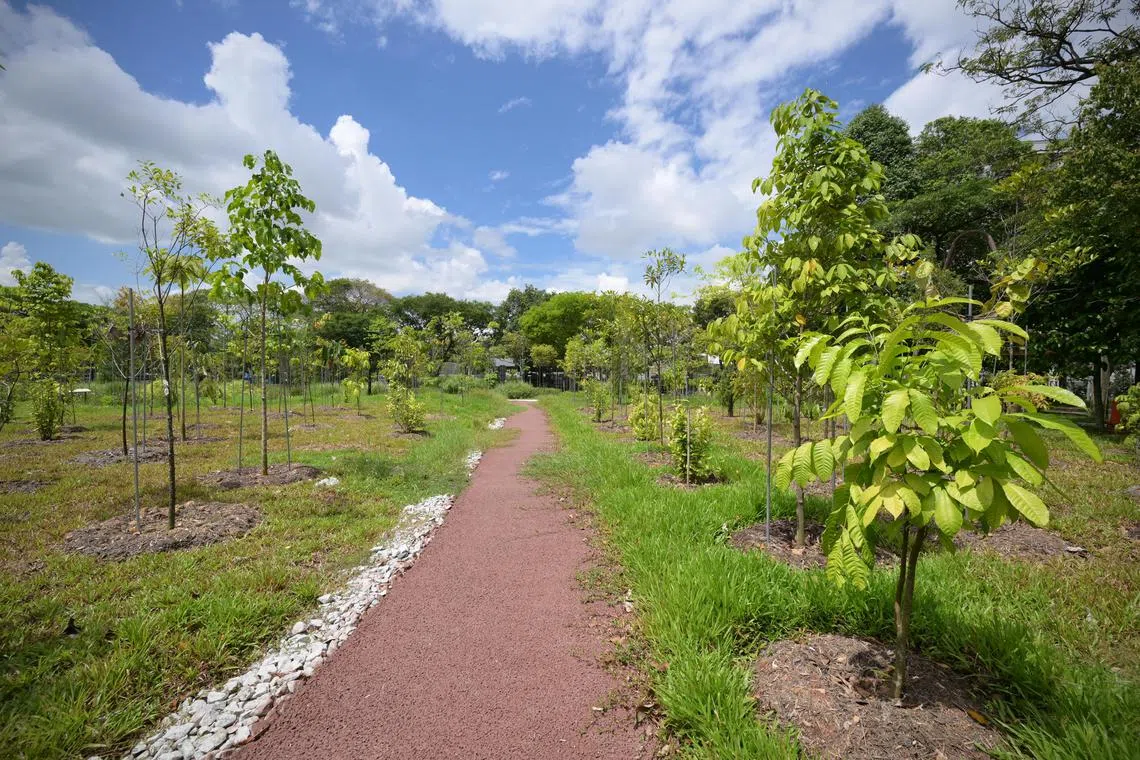Two interim parks take root in Taman Jurong to bring nature closer to residents
Sign up now: Get ST's newsletters delivered to your inbox

The Taman Damai interim park is one of two green spaces that have taken root in Taman Jurong over the past few months.
ST PHOTO: NG SOR LUAN
Follow topic:
SINGAPORE – What used to be a long and narrow rectangular plot of rich orange dirt within the Lake Vista estate in Hu Ching Road is now a bed of green grass, shrubs, saplings and a community garden. Spanning the length of the estate at approximately 200m, this verdant space has become home to an assortment of birds and butterflies.
Opened on Aug 3, 2024, the Taman Damai interim park is one of two green spaces that have taken root in Taman Jurong over the past few months.
The Taman Jurong Oasis interim park, in what used to be a small grass field and extending from the existing Taman Jurong Greens in Yung An Road, opened on Nov 9, 2024.
They are among at least 25 other interim parks across Singapore, which experts say can help to bring the benefits of greenery closer to heartland folk.
Interim parks are green spaces developed on vacant land with no immediate development plans, according to the National Parks Board (NParks).
Some interim parks like Taman Damai and Taman Jurong Oasis are initiatives started by grassroots organisations.
While the authorities developed these plots, resident volunteers contribute to maintaining, for example, the community garden.

The Taman Damai interim park opened on Aug 3, 2024.
ST PHOTO: NG SOR LUAN
The concept of the parks was initiated by members of the Taman Jurong Citizens Consultative Committee (CCC) and its Green@Heart interest group in 2021, in a discussion involving residents and NParks representatives.
Said a spokesperson for Taman Jurong CCC: “The primary objective is to involve the community in appreciating green spaces. It is also a green space for residents to come together for activities, and to enjoy the benefits of nature on their doorsteps.”
The Taman Damai interim park features an allotment garden where residents can lease plots to grow their own plants and edibles, and a community garden where people can plant similar flora for sharing.
With fruiting flora like samrong (Sterculia parviflora) and seashore ardisia (Ardisia elliptica), the park has welcomed fauna like the oriental pied hornbill (Anthracoceros albirostris) and harlequin butterflies (Taxila haquinus haquinus).
The highlight of the Taman Jurong Oasis interim park is a footpath made of porous asphalt, which combines bitumen (a dense, sticky substance with waterproofing capabilities) and granite to create a flexible pavement structure with many air spaces. These spaces store and purify water in the drainage gravel, significantly reducing the risk of flooding.
With water design features such as vegetated swales, stormwater run-off is slowed down and purified simultaneously. A vegetated swale is a broad, shallow canal filled with plants and small stones that naturally channels away and drains excess rainwater.
Trees found here include the marsh holly (Ilex cymosa), white gutta (Palaquium obovatum) and seashore mangosteen (Garcinia celebica).
“Unlike the usual parks, the concept was to allow the park to remain naturalistic while allowing the plants to grow wild and rustic, so that residents may enjoy the benefits of nature and participate in community-led activities like guided walks and birdwatching,” the spokesperson added.

The Taman Jurong Oasis interim park opened on Nov 9, 2024.
ST PHOTO: NG SOR LUAN
Despite the temporary nature of these green spaces, landscape suppliers like Chop Ching Hin see the value of supplying plants for such initiatives.
Mr Zac Toh, founder of Chop Ching Hin’s social enterprise wing City Sprouts, said: “From our experience with starting City Sprouts, I’ve seen how these parks can bring different people together in a green space. On a psychological and mental level, these park spaces provide individuals with refuge and resilience to thrive in our fast-paced city.”
A study published in 2024 by Nanyang Technological University (NTU) and the Singapore University of Technology and Design (SUTD) found that “more than 70 per cent of the respondents expressed that they would not mind having more nature in their neighbourhood, even though they indicated that the current amount of nature was adequate”.
“The evolving landscape preferences suggest that people might have grown conscious of social-ecological benefits and other values of wilder greenery central to human well-being,” the study noted.
Despite a separate study that was reviewed in the paper suggesting that Singapore residents are receptive to spontaneous vegetation and wilder urban greenery, the results of the joint study by NTU and SUTD were unable to verify this.
“While there have been positive perceptions of nature’s contribution to people and interests in various modes of nature engagement, this information alone is insufficient to infer respondents’ receptiveness about the landscape, forms and wilderness aspects of tiny forests,” the study noted.
Interim parks serve as a good first step to challenge people’s perceptions of wilder landscapes – to accept wilder nature and wildlife, said NTU associate principal biodiversity consultant Ngo Kang Min, who was part of the study.
“This is the first step to get people comfortable with nature that is more than a lawn. I believe that as the trees grow, the cooling effect will be greater, and people should feel them over time,” she added.
Ms Gan Wen Xin, a Lake Vista resident of three years, said the Taman Damai interim park provides a convenient location to take her pet corgi for walks.
“It used to be a barren plot of land, so it’s really nice that there’s greenery now. It feels calming. The maintenance, however, is not great. The interval between landscaping works is quite long,” said the 30-year-old partnerships manager.
She added: “It is quite a pity that this is going to be a temporary park, and we don’t know when it will be redeveloped.”
At the newer Taman Jurong Oasis interim park, Mr Tian Lai, 75, a resident of more than 20 years, said: “It’s prettier with the addition of new trees and plants in the extended interim park, but it’s not any breezier. At least it hasn’t inconvenienced me – no pest issue, so that’s great.”
On the temporary nature of the initiative, the retiree added: “Singapore has always done this, so I don’t think it’s that bad. Our land is so limited, the Government also has no choice.”
Correction note: In an earlier version of the story, we referred to Chop Ching Hin as a landscape contractor instead of supplier. This has been corrected.

